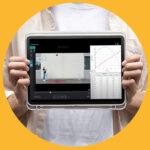
Sharing ideas and inspiration for engagement, inclusion, and excellence in STEM

Vernier offers more than 1,000 experiments in biology, chemistry, engineering/robotics, and physics that can promote STEM literacy and help you integrate data-collection technology into your courses.
Biology
To conduct this inquiry experiment, students use the Go Direct® Gas Pressure Sensor or Gas Pressure Sensor. The objectives of the experiment include
- Measure transpiration rates under different conditions.
- Use reference sources to find out more about transpiration before choosing and investigating a researchable question. Some topics to consider are listed below:
- transpiration
- cohesion-tension theory
- water potential
- osmosis
- stomata
- water potential gradient
- xylem
- mesophyll cell
Check out a short video related to this experiment.
Chemistry
“Determining the Mole Ratios in a Chemical Reaction”
To conduct this experiment, students use the Go Direct Temperature Probe or Stainless Steel Temperature Probe. The objectives of the experiment include
- Measure the enthalpy change of a series of reactions.
- Determine the stoichiometry of an oxidation-reduction reaction in which the reactants are known but the products are unknown.
Physics
“Simple Harmonic Motion: Kinematics and Dynamics”
To conduct this experiment, students use the Motion Detector, Dual-Range Force Sensor, and Springs Set.
The objectives of the experiment include
- Collect position vs. time data as a weight, hanging from a spring, is set in simple harmonic motion (SHM).
- Determine the best-fit equation for the position vs. time graph of an object undergoing SHM.
- Define the terms “amplitude,” “offset,” “phase shift,” “period,” and “angular frequency” in the context of SHM.
- Predict characteristics of the corresponding velocity vs. time and acceleration vs. time graphs, produce these graphs, and determine best-fit equations for them.
- Relate the net force and acceleration for a system undergoing SHM.
Share this Article

Sign up for our newsletter
Stay in the loop! Beyond Measure delivers monthly updates on the latest news, ideas, and STEM resources from Vernier.






